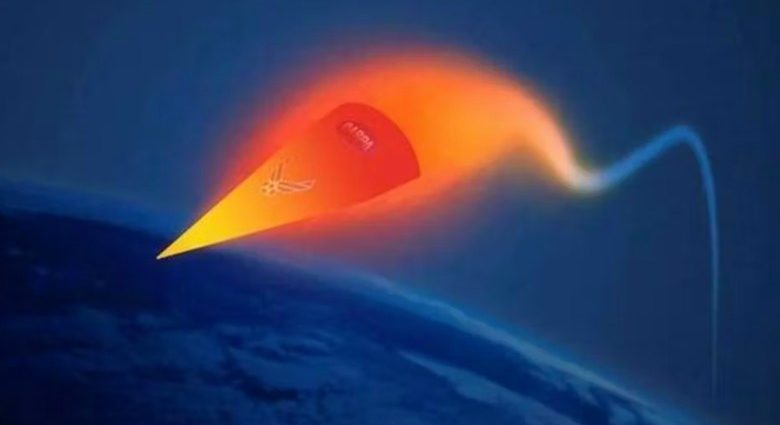US researchers have discovered a new cooling method that reputedly solves overheating problems associated with hypersonic weapons, potentially enabling new levels of accuracy for tactical use and strategic missile defense.
This month, Defense One reported that researchers from the University of Virginia, supported by a US Air Force grant, have devised a plasma cooling method to protect sensitive electronics from the extreme heat generated by flying at high speeds.
That, in turn, could allow for the development of hypersonic weapons with much more advanced electronic guidance and even enable on-the-ground weapons to evade hypersonic-tracking heat sensors.
If so, the plasma-cooling innovation could give the US a new edge in the crucial race with China and Russia to deploy hypersonic missiles and new spacecraft. The University of Virginia science team published their research paper this July in the American Chemical Society’s journal ACS Nano.
Patrick Hopkins, one of the paper’s researchers, said to Defense One that his team began creating a laser that could measure the temperature of a sample’s surface with a level of accuracy within a microsecond and observed that the temperature of the surface changed when the plasma hit it.
Hopkins and his team noted that during the development of the laser probe they noticed that the surface cooled down first, then heated up due to energetic species from the plasma. They said that the temperature drop is the same reason focused plasma can be used to clean electronics.
They also noted that plasma can remove atoms from the sample surface, effectively reducing the material’s temperature, with significant consequences for the future of hypersonic missiles, spacecraft or other vehicles where high heat could hurt electronics.
Defense One says focused plasma can benefit high-heat vehicles such as hypersonic missiles and spacecraft. The plasma cooling effect also helps to cloak the thermal signature of some power-hungry electronic systems like radars or high-powered radio devices.
The innovation could also improve the accuracy of hypersonic weapons. During hypersonic flight, the missile’s skin develops a plasma layer hotter than the sun’s surface, degrading the performance of traditional infrared (IR) seekers which require extremely cold temperatures to function.

Hopkins’ team’s innovation and similar advancements in cooling technology may allow new types of IR seekers to be mounted on hypersonic weapons, which may be in line with developing US doctrine regarding their use.
However, a Chinese team may have first developed the IR seeker technology breakthrough for hypersonic weapons.
Asia Times reported in May 2022 that a research team from the PLA Rocket Force University of Engineering in Xian had been given until 2025 to solve the problems associated with IR seekers on hypersonic weapons by developing a new heat-seeking guidance system.
The team’s new method uses data collected by motion sensors to adjust every pixel to ensure consistency between earlier shots regarding viewing angle, lighting or size.
A separate team from China’s Xidian University has developed new heat-seeking technology to detect heat signatures over distance, even at hypersonic speeds. The technology reputedly allows hypersonic missiles to hit targets as small as drones with 90% accuracy.
At the strategic level, a February 2023 report by the Congressional Research Service (CRS) discusses the development of hypersonic weapons for specific missions. The report emphasizes the importance of evaluating their cost-effectiveness, integrating them into joint operational doctrine and carefully planning deployment.
It also mentions that US hypersonics armed with conventional warheads are meant to be used against hardened or time-sensitive targets, implying a greater accuracy requirement and a more tactical role – and thus more complex to develop – than those of China and Russia.
Alan Cummings says in a November 2019 War on the Rocks article that US defense messaging focuses on deterring adversaries like China and Russia and reassuring allies. Cummings points out that hypersonic weapons can achieve these goals by providing combat capabilities, enabling synchronized attacks against Chinese forces and demonstrating determination.
He also says that deploying hypersonic missiles overseas can symbolize interest and resolve, as their limited initial availability makes them powerful tools for diplomatic leverage.
In line with that, Asia Times reported in December 2022 that US land-based hypersonic missile launchers such as Operational Fires (OpFires) are more survivable and cost-effective than ship-borne systems. They can complement air and naval power by serving as a near-constant presence in contested areas.
OpFires and similar projects like Typhon missile defense signify a shift in US strategy from doing things independently to enabling allies to implement their own anti-access/area denial (A2/AD) bubbles, aligning with the US “missile wall” plan in the Pacific to deter China.
US grand strategy has constantly been undermined by over-commitment, and with China’s growing power, this approach is probably no longer viable in the Pacific.
However, finding a US partner willing to host missile systems such as OpFires is far more challenging than looking for partners to host other types of US military presence such as air and naval bases.
Meanwhile, improvements in hypersonic missile accuracy can enable the development of hypersonic interceptors, which would be the next evolution of missile-based defenses.

This month, Asia Times reported that Japan and the US are collaborating to develop a hypersonic missile interceptor against rising threats from China and North Korea.
The Japanese Ministry of Defense plans to overhaul its Type 03 surface-to-air missile (SAM) to shoot down hypersonic glide vehicle (HGV) weapons, upgrade its launch software by 2026 and start production of the upgraded missiles by 2029.
The Type 03 will soon be upgraded to detect, track and predict hypersonic weapons, with the program possibly using technology from the US Glide Phase Interceptor (GPI) program, which reports indicate is now facing funding issues.

